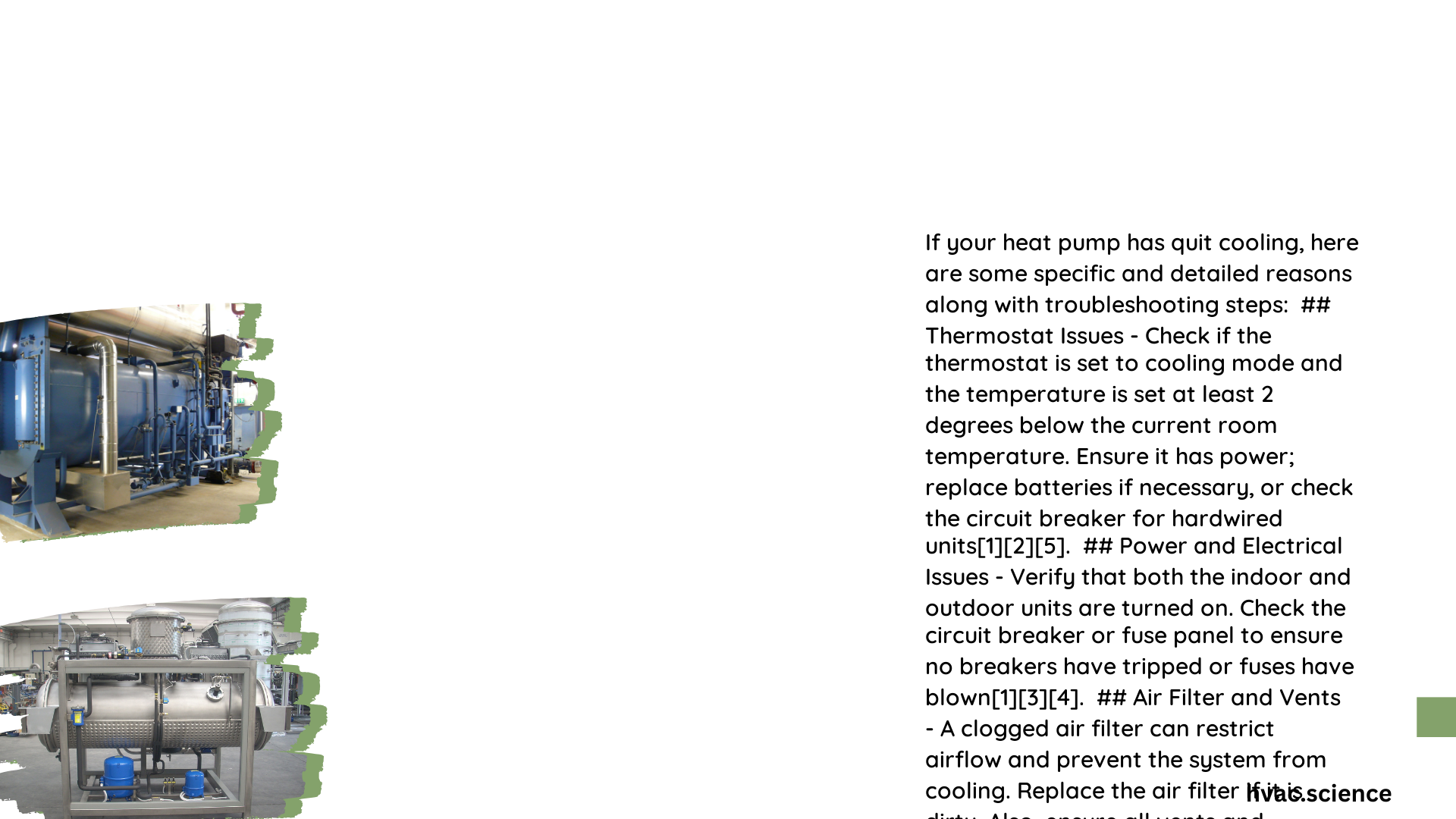When a heat pump stops cooling, it can be frustrating and uncomfortable. This comprehensive guide addresses common issues causing heat pumps to quit cooling, including thermostat malfunctions, refrigerant leaks, compressor problems, and electrical issues. We’ll provide step-by-step troubleshooting techniques, diagnostic methods, and potential solutions to help restore your heat pump’s cooling function efficiently.
Why Has My Heat Pump Stopped Cooling?
Heat pumps are complex systems that can stop cooling for various reasons. Common causes include:
- Thermostat issues
- Refrigerant leaks
- Compressor problems
- Electrical faults
- Airflow restrictions
Let’s dive into each of these potential problems and their solutions.
What Are the First Steps in Diagnosing a Heat Pump That Won’t Cool?

When your heat pump quits cooling, follow these initial diagnostic steps:
- Check the thermostat settings
- Inspect the air filter
- Examine the outdoor unit
- Verify electrical connections
Thermostat Check
- Ensure the thermostat is set to ‘Cool’ mode
- Set the temperature lower than the current room temperature
- Check if the display is working and showing the correct information
Air Filter Inspection
- Locate the air filter (usually in the return air duct or indoor unit)
- Remove the filter and check for dirt or debris
- Clean or replace the filter if necessary
Outdoor Unit Examination
- Clear any debris around the outdoor unit
- Check for ice buildup on the coils
- Listen for unusual noises when the unit is running
Electrical Connection Verification
- Check if the circuit breaker has tripped
- Inspect visible wiring for signs of damage
- Ensure the disconnect switch near the outdoor unit is in the ‘On’ position
How Can I Identify and Fix Refrigerant Leaks?
Refrigerant leaks are a common cause of heat pumps quitting cooling. Here’s how to identify and address them:
Signs of Refrigerant Leaks
- Reduced cooling efficiency
- Ice buildup on the evaporator coil
- Hissing sounds near the indoor or outdoor unit
- Higher than normal energy bills
Leak Detection Methods
- Visual inspection for oil stains
- Electronic leak detectors
- Soap bubble test
- UV dye test
Refrigerant Leak Repair Process
- Locate the leak using detection methods
- Repair the leak (usually requires professional assistance)
- Evacuate the system
- Recharge with the correct amount of refrigerant
Note: Refrigerant handling requires EPA certification. It’s best to contact a professional HVAC technician for this task.
What Are Common Compressor Issues That Cause Cooling Failure?
The compressor is the heart of your heat pump. When it fails, cooling stops. Here are common compressor issues:
| Issue | Symptoms | Possible Causes |
|---|---|---|
| Overheating | Frequent shutdowns, reduced cooling | Dirty coils, low refrigerant |
| Electrical failure | No operation, tripped breaker | Wiring issues, capacitor failure |
| Mechanical failure | Loud noises, no cooling | Worn parts, lack of lubrication |
Diagnosing Compressor Problems
- Listen for unusual noises (grinding, rattling)
- Check for vibrations in the outdoor unit
- Measure amperage draw (requires professional tools)
- Inspect capacitor for signs of failure (bulging, leaking)
Compressor Repair or Replacement
- Minor issues may be repairable (e.g., capacitor replacement)
- Major failures often require compressor replacement
- Consider the age of the unit when deciding between repair and replacement
How Do I Troubleshoot Electrical Issues in My Heat Pump?
Electrical problems can cause your heat pump to quit cooling. Here’s how to troubleshoot:
- Check the circuit breaker
- Locate the breaker for your heat pump
- If tripped, reset it once
-
If it trips again, call a professional
-
Inspect the disconnect switch
- Ensure it’s in the ‘On’ position
-
Look for signs of damage or corrosion
-
Examine visible wiring
- Check for frayed or chewed wires
-
Look for loose connections
-
Test the capacitor (professional tool required)
-
A failed capacitor can prevent the compressor from starting
-
Check the contactor
- Listen for a clicking sound when the thermostat calls for cooling
- If no click, the contactor may need replacement
Warning: Electrical work can be dangerous. If you’re unsure, always consult a licensed HVAC technician.
What Maintenance Can Prevent My Heat Pump from Quitting Cooling?
Regular maintenance is key to preventing cooling failures. Here’s a maintenance checklist:
- [ ] Clean or replace air filters monthly
- [ ] Keep the outdoor unit clear of debris
- [ ] Clean indoor and outdoor coils annually
- [ ] Check and tighten electrical connections yearly
- [ ] Inspect refrigerant levels and check for leaks annually
- [ ] Lubricate moving parts as needed
- [ ] Test thermostat function regularly
- [ ] Schedule professional maintenance twice a year
By following this maintenance routine, you can significantly reduce the chances of your heat pump quitting cooling unexpectedly.
When Should I Call a Professional for My Heat Pump Cooling Issues?
While some troubleshooting can be done by homeowners, certain situations require professional help:
- Refrigerant leaks or recharging
- Electrical issues beyond simple breaker resets
- Compressor failures or strange noises
- Persistent cooling problems despite basic troubleshooting
- Annual or bi-annual maintenance checks
Remember, attempting complex repairs without proper knowledge can lead to further damage or safety hazards.
By understanding these common issues and following the troubleshooting steps, you can often identify why your heat pump quit cooling and take appropriate action. Regular maintenance and prompt attention to problems will help ensure your heat pump provides reliable cooling for years to come.
References:
1. CieloWigle – Heat Pump Troubleshooting
2. HPAC Magazine – Heat Pump Troubleshooting Tips
3. Conway Services – Heat Pump Troubleshooting
